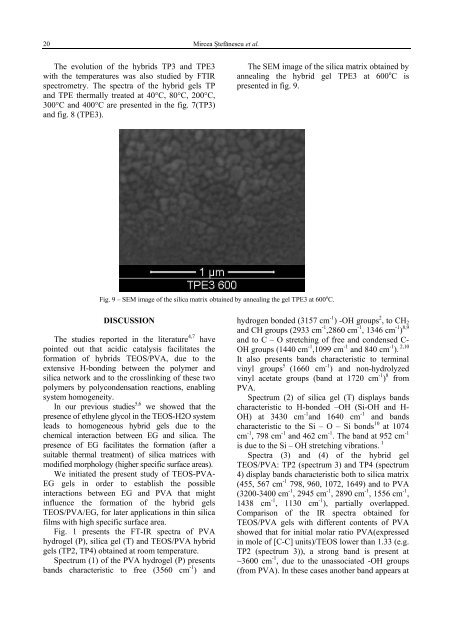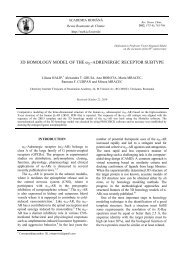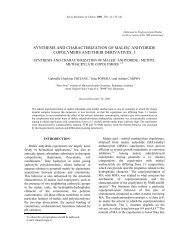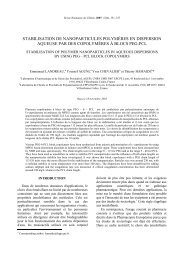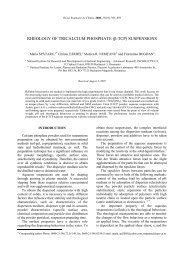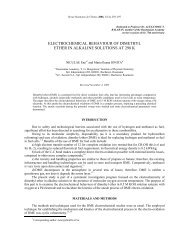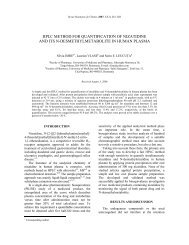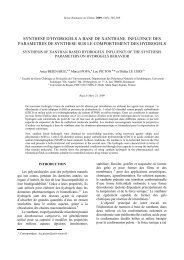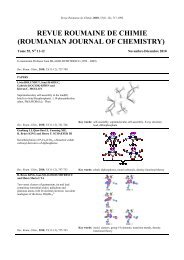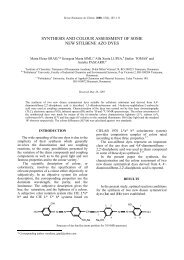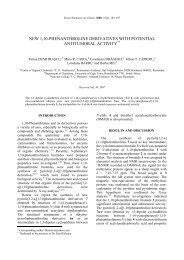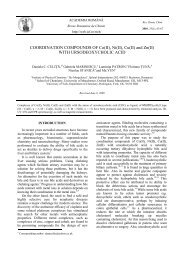synthesis and characterization of poly(vinyl alcohol)/ethylene glycol ...
synthesis and characterization of poly(vinyl alcohol)/ethylene glycol ...
synthesis and characterization of poly(vinyl alcohol)/ethylene glycol ...
Create successful ePaper yourself
Turn your PDF publications into a flip-book with our unique Google optimized e-Paper software.
20 Mircea Ştefănescu et al.The evolution <strong>of</strong> the hybrids TP3 <strong>and</strong> TPE3with the temperatures was also studied by FTIRspectrometry. The spectra <strong>of</strong> the hybrid gels TP<strong>and</strong> TPE thermally treated at 40°C, 80°C, 200°C,300°C <strong>and</strong> 400°C are presented in the fig. 7(TP3)<strong>and</strong> fig. 8 (TPE3).The SEM image <strong>of</strong> the silica matrix obtained byannealing the hybrid gel TPE3 at 600 o C ispresented in fig. 9.Fig. 9 – SEM image <strong>of</strong> the silica matrix obtained by annealing the gel TPE3 at 600 o C.DISCUSSIONThe studies reported in the literature 4,7 havepointed out that acidic catalysis facilitates theformation <strong>of</strong> hybrids TEOS/PVA, due to theextensive H-bonding between the <strong>poly</strong>mer <strong>and</strong>silica network <strong>and</strong> to the crosslinking <strong>of</strong> these two<strong>poly</strong>mers by <strong>poly</strong>condensation reactions, enablingsystem homogeneity.In our previous studies 5,6 we showed that thepresence <strong>of</strong> <strong>ethylene</strong> <strong>glycol</strong> in the TEOS-H2O systemleads to homogeneous hybrid gels due to thechemical interaction between EG <strong>and</strong> silica. Thepresence <strong>of</strong> EG facilitates the formation (after asuitable thermal treatment) <strong>of</strong> silica matrices withmodified morphology (higher specific surface areas).We initiated the present study <strong>of</strong> TEOS-PVA-EG gels in order to establish the possibleinteractions between EG <strong>and</strong> PVA that mightinfluence the formation <strong>of</strong> the hybrid gelsTEOS/PVA/EG, for later applications in thin silicafilms with high specific surface area.Fig. 1 presents the FT-IR spectra <strong>of</strong> PVAhydrogel (P), silica gel (T) <strong>and</strong> TEOS/PVA hybridgels (TP2, TP4) obtained at room temperature.Spectrum (1) <strong>of</strong> the PVA hydrogel (P) presentsb<strong>and</strong>s characteristic to free (3560 cm -1 ) <strong>and</strong>hydrogen bonded (3157 cm -1 ) -OH groups 2 , to CH 2<strong>and</strong> CH groups (2933 cm -1 ,2860 cm -1 , 1346 cm -1 ) 8,9<strong>and</strong> to C – O stretching <strong>of</strong> free <strong>and</strong> condensed C-OH groups (1440 cm -1 ,1099 cm -1 <strong>and</strong> 840 cm -1 ). 2,10It also presents b<strong>and</strong>s characteristic to terminal<strong>vinyl</strong> groups 5 (1660 cm -1 ) <strong>and</strong> non-hydrolyzed<strong>vinyl</strong> acetate groups (b<strong>and</strong> at 1720 cm -1 ) 8 fromPVA.Spectrum (2) <strong>of</strong> silica gel (T) displays b<strong>and</strong>scharacteristic to H-bonded –OH (Si-OH <strong>and</strong> H-OH) at 3430 cm -1 <strong>and</strong> 1640 cm -1 <strong>and</strong> b<strong>and</strong>scharacteristic to the Si – O – Si bonds 10 at 1074cm -1 , 798 cm -1 <strong>and</strong> 462 cm -1 . The b<strong>and</strong> at 952 cm -1is due to the Si – OH stretching vibrations. 1Spectra (3) <strong>and</strong> (4) <strong>of</strong> the hybrid gelTEOS/PVA: TP2 (spectrum 3) <strong>and</strong> TP4 (spectrum4) display b<strong>and</strong>s characteristic both to silica matrix(455, 567 cm -1 798, 960, 1072, 1649) <strong>and</strong> to PVA(3200-3400 cm -1 , 2945 cm -1 , 2890 cm -1 , 1556 cm -1 ,1438 cm -1 , 1130 cm -1 ), partially overlapped.Comparison <strong>of</strong> the IR spectra obtained forTEOS/PVA gels with different contents <strong>of</strong> PVAshowed that for initial molar ratio PVA(expressedin mole <strong>of</strong> [C-C] units)/TEOS lower than 1.33 (e.g.TP2 (spectrum 3)), a strong b<strong>and</strong> is present at~3600 cm -1 , due to the unassociated -OH groups(from PVA). In these cases another b<strong>and</strong> appears at


